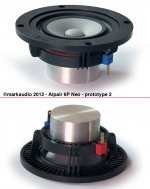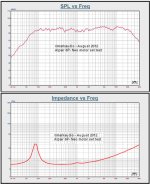Hi Guys,
Here's an Neodymium Motor Set experiment produced by Evan Yu on an Alpair 6P driver. The design is a modified U Yoke type. The housing has been CNC'd to trial run on the rear of the 6P's frame, being bonded into position. Its an early experiment for this driver using Neo.
Apologies for the small graphs and dark photos. Very busy right now so don't have the time to make high-res.
I did snatch a quick 10 mins of listening time on this driver last week. I was impressed. Very clear and detailed. Ummmmmmmph........need more time and still cost issues to consider. Given past rare earth price increases.........?? But as a driver, it does have technical performance potential.
Will be interesting to compare to the current model. Notice the extended high range, slight increase in SPL and with a workable total Q. All credit to Evan.
Revc= 6.800 Ohm
Fo= 79.140 Hz
Sd= 36.317 cm²
Vas= 3.331 Ltr
Cms= 1.778m M/N
Mmd= 2.148m Kg
Mms= 2.274 g
BL= 3.058 T·M
Qms= 1.258
Qes= 0.822
Qts= 0.497
Levc= 6.410u H
No= 0.194 %
SPLo= 84.899 dB
Cheers
Mark.
Here's an Neodymium Motor Set experiment produced by Evan Yu on an Alpair 6P driver. The design is a modified U Yoke type. The housing has been CNC'd to trial run on the rear of the 6P's frame, being bonded into position. Its an early experiment for this driver using Neo.
Apologies for the small graphs and dark photos. Very busy right now so don't have the time to make high-res.
I did snatch a quick 10 mins of listening time on this driver last week. I was impressed. Very clear and detailed. Ummmmmmmph........need more time and still cost issues to consider. Given past rare earth price increases.........?? But as a driver, it does have technical performance potential.
Will be interesting to compare to the current model. Notice the extended high range, slight increase in SPL and with a workable total Q. All credit to Evan.
Revc= 6.800 Ohm
Fo= 79.140 Hz
Sd= 36.317 cm²
Vas= 3.331 Ltr
Cms= 1.778m M/N
Mmd= 2.148m Kg
Mms= 2.274 g
BL= 3.058 T·M
Qms= 1.258
Qes= 0.822
Qts= 0.497
Levc= 6.410u H
No= 0.194 %
SPLo= 84.899 dB
Cheers
Mark.
Attachments
Last edited:
Interesting. Big congrats. to Evan for his experimental work & design creativity. Looks like it has a little less electrical (and mechanical) damping than the standard driver, but nice flat response trend.
Hmm. I might be missing something, but according to the data, SPL is actually a little down compared to the stock unit (84.889db plays 86dB). Given the different sizes & slightly different scales of the graphs, it's difficult to compare accurately, but there doesn't seem to be much more additional HF extension either? SPLs at 20KHz look to be similar at ~85dB, and roughly 75dB at 30KHz.
Either way, nice driver, but on the present evidence I can't really see any reason to select it over the existing unit, especially given the cost of neodymium which will presumably mean it would need to be priced substantially higher. If it exhibits substantial improvements elsewhere, e.g. lower HD etc., then that's another matter, & I'm all for it.
Hmm. I might be missing something, but according to the data, SPL is actually a little down compared to the stock unit (84.889db plays 86dB). Given the different sizes & slightly different scales of the graphs, it's difficult to compare accurately, but there doesn't seem to be much more additional HF extension either? SPLs at 20KHz look to be similar at ~85dB, and roughly 75dB at 30KHz.
Either way, nice driver, but on the present evidence I can't really see any reason to select it over the existing unit, especially given the cost of neodymium which will presumably mean it would need to be priced substantially higher. If it exhibits substantial improvements elsewhere, e.g. lower HD etc., then that's another matter, & I'm all for it.
Last edited by a moderator:
Hi Scott (Guys)
Apologies, yes SPL is a little lower than the existing Ferrite model. What happens when one try's to do things in a rush. I'll be back at our workshop end of next week as I'd like to explore with Evan, the possibility to increases the magnet strength on this prototype. There is some flexibility on the T/S indications that could allow us to push electrical damping a little more. Worth trying as we might gain extra SPL while boosting high range.
Cheers
Mark
Apologies, yes SPL is a little lower than the existing Ferrite model. What happens when one try's to do things in a rush. I'll be back at our workshop end of next week as I'd like to explore with Evan, the possibility to increases the magnet strength on this prototype. There is some flexibility on the T/S indications that could allow us to push electrical damping a little more. Worth trying as we might gain extra SPL while boosting high range.
Cheers
Mark
The neo looks good,
It would solve the problem of a heavy magnet on a poly frame--since small speakers tend to be knocked around more, the lighter they are the better.
Did a gravity test on a surround speaker 2 meters up--the heavy magnet warped the speaker frame and it was game over. (Not a MA driver)
Neo prices are going down a bit, in the next year they should drop considerably since more mines are opening and going into production. Eventually I'll build a pair of MA speakers for my computer desk, I know those will hit the floor eventually so neo makes sense for that. The charts look good so looking forward to neo.
It would solve the problem of a heavy magnet on a poly frame--since small speakers tend to be knocked around more, the lighter they are the better.
Did a gravity test on a surround speaker 2 meters up--the heavy magnet warped the speaker frame and it was game over. (Not a MA driver)
Neo prices are going down a bit, in the next year they should drop considerably since more mines are opening and going into production. Eventually I'll build a pair of MA speakers for my computer desk, I know those will hit the floor eventually so neo makes sense for that. The charts look good so looking forward to neo.
Guys, Mark said it was an experimental pair, no more. As I read it, this is a one-off pair of units modified by Evan. Assuming something like it did go into production, before any kind of end price could realisitcally be determined, the cost of the new magnets, yoke, frame & tooling would need to be ascertained.
Last edited:
It should not be too costly,
They are full ranges, not woofers or subwoofers so considerably less expensive since so much neo is not needed or desired.
In theory, I've heard neo "can" improve high frequencies so worth looking into. Might do the trick with the A10 and 12P since the larger drivers would embrace any additional treble response.
No stone left unturned with Mark--should be educational to see how this plays out.
They are full ranges, not woofers or subwoofers so considerably less expensive since so much neo is not needed or desired.
In theory, I've heard neo "can" improve high frequencies so worth looking into. Might do the trick with the A10 and 12P since the larger drivers would embrace any additional treble response.
No stone left unturned with Mark--should be educational to see how this plays out.

Mark - how do you explain the rather significant difference in the impedance spikes between the neo and Alnicos posted in the other thread, and have any of these been listened to yet?
Hi Chris,
I think you're referring to the CHR-Alnic test unit. Its got a weak strength motor, hence the very limited impedance output.
The Alpair 6P Neo had a quick listen (already commented in that thread)
Thanks
Mark.
It should not be too costly,
They are full ranges, not woofers or subwoofers so considerably less expensive since so much neo is not needed or desired.
In theory, I've heard neo "can" improve high frequencies so worth looking into. Might do the trick with the A10 and 12P since the larger drivers would embrace any additional treble response.
No stone left unturned with Mark--should be educational to see how this plays out.
Hi 18,
Neo is mostly used on small drivers where space saving is critical. Due to its cost, its rarely used on larger units.
Thanks
Mark
- Status
- This old topic is closed. If you want to reopen this topic, contact a moderator using the "Report Post" button.
- Home
- Loudspeakers
- Full Range
- Neodymium Experiment

